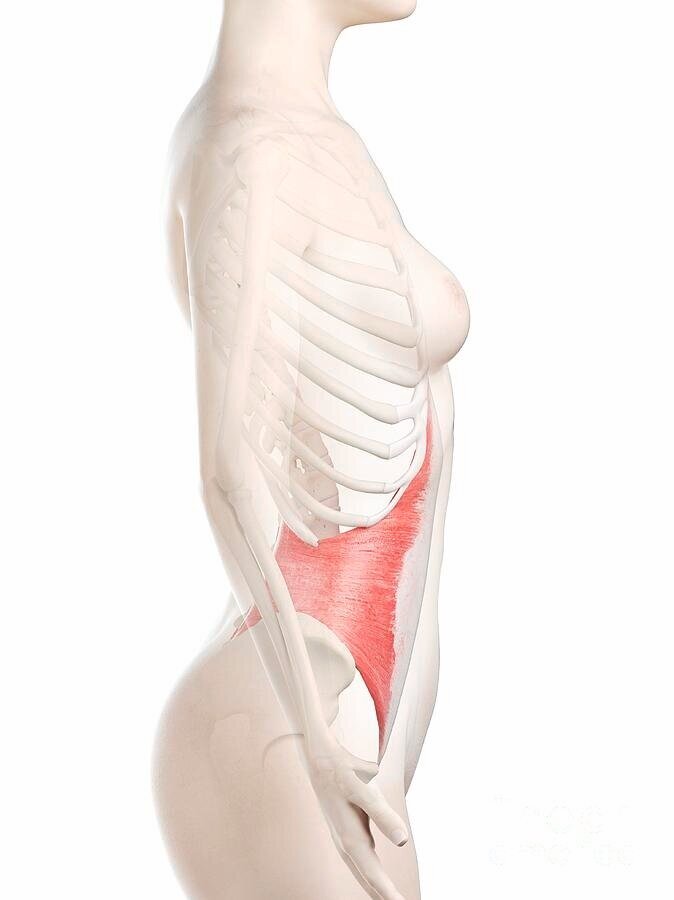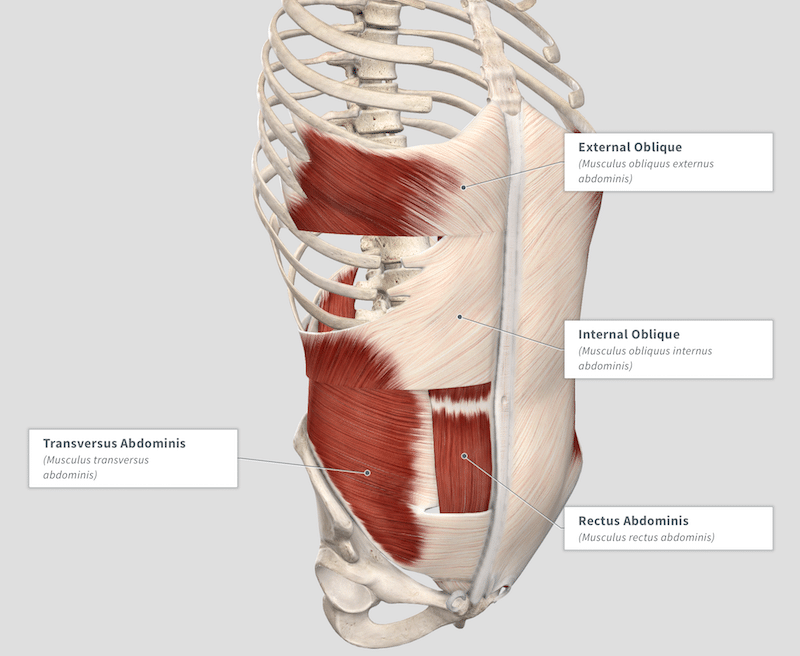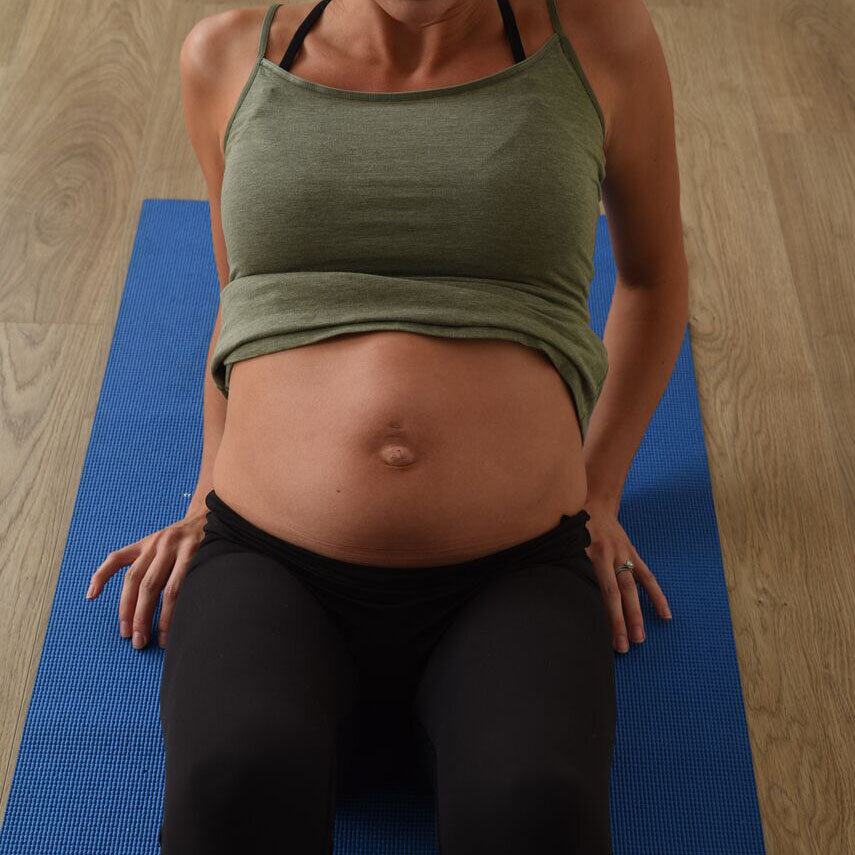Transversus Abdominis A.K.A The Deep Core
In this blog, we will discuss your transversus abdominis (TA) muscle and how it contributes to preventing and/or treating back and pelvic girdle pain.
To explain this, we firstly need to refresh you on your abdominal wall anatomy:
The left and right abdominal muscles are innervated separately, and are joined together at the front by a central ligament called the Linea Alba (an easy way to remember the name of this central ligament is thinking about actress Jessica Alba :P).
Your abdominal wall is made up of 3 distinct layers
1st Layer: Rectus Abdominis (Six Pack Muscle, the outermost layer that is closest to the skin)
2nd Layer: Obliques
3rd Layer: Transversus Abdominis (Deep Core, deepest layer that is furthest from the skin)
Rectus Abdominis (Six-Pack Muscle)
The first layer or outer most layer of the abdominal wall is rectus abdominis (also known as your ‘six-pack’ muscle). Your rectus is a powerful muscle that flexes your trunk, such as when you crunch and sit-up to get out of bed. Rectus strength is very important especially in the pregnant and early postnatal population. This is because the rectus supports the linea alba (the central ligament to which the left and right abdominal muscles insert into). A strong rectus in pregnancy and postpartum ensures a great anchor point for the TA to pull from.
In the non-pregnant population the linea alba is usually stiff and therefore a great anchor point for the abdominal muscles to pull from in order to provide stability to the spine and pelvis. However, in pregnancy, this changes, and the linea alba is no longer stiff. This is due to the rising levels of oestrogen and progesterone throughout pregnancy. Due to these rising hormone levels, the linea alba becomes very soft and super stretchy, in turn, making it a suboptimal anchor point for the abdominal muscles to pull from. However, if your rectus abdominis is strong pre-pregnancy and stays strong throughout your pregnancy this can compensate for the progressive softening of the linea alba. A strong rectus in pregnancy creates a strong central anchor point for the TA and obliques to pull from. This is important because when TA and obliques activate, intra-abdominal pressure increases, which stabilises the spine and pelvis during movement.
If the rectus muscle is weak, and the linea alba is stretchy, the abdominal muscles do not have a stable base to pull from, resulting in poor core function. This may contribute to pregnancy-related pelvic girdle pain, and may reduce the ability of the abdominal wall to push effectively during childbirth.
Obliques
Your second abdominal layer, your obliques, is responsible for trunk rotation, such as when you turn to look over your shoulder.
Transversus Abdominis (Deep Core)
Last, but definitely not least, is your TA muscle, which makes up the third and deepest layer of your abdominal wall. The TA is often referred to as your “deep or inner core”. Unlike your rectus and obliques, your TA is not a “powerful” muscle, but has a larger proportion of slow twitch muscle fibres, allowing it to gently contract over longer periods of time - often without your conscious thought. In other words, your TA silently hums away all day long, providing subtle and deep support to your back and pelvis. It is also responsible for postural endurance, allowing you to sit, stand or walk without getting achy in your back and hips. Your TA, along with lower rectus, contributes to the contour of your tummy, which is always a plus!
From research we know that your TA should automatically turn on (just a little bit) prior to exertion. In other words, your TA should turn on a few milliseconds before you cough, sneeze, lift, or stand up from a chair. This automatic function can sometimes go out the window if you experience back or pelvic girdle pain/dysfunction.
Retraining of the abdominal wall, including your TA, is an essential part of your back and pelvic girdle rehabilitation, as it is vital in regaining the deep and subtle support to your spine and pelvis. It’s important to mention that all the layers of your abdominal wall are equally important and work together in synchronicity to provide support to your spine and pelvis. In other words, having a good TA but weak rectus and obliques is not adequate enough to prevent or treat back and pelvic girdle pain. And there is emerging research that having a strong TA but weak rectus may in fact even be detrimental during pregnancy, and could contribute to severe and non-resolving tummy muscle separation, and negative birth outcomes. Please note: this does not mean pregnant women should be performing sit-ups during pregnancy and the early post-partum period!! But what it does mean, is rectus activation should not be deterred in pregnancy and early post-partum period. There are lots of ways to maintain the strength of the rectus muscle in pregnancy other than sit-ups! Our TPS physios are experts in guiding pregnancy-friendly exercise, including rectus and abdominal wall exercises. CLICK HERE to book with one of our physios today to get your pregnancy exercise rehab program started!
A well-functioning TA also helps to prevent and/or treat abdominal doming (also referred to as coning or tenting), which commonly occurs in the later stages of pregnancy and in the early postnatal period, but can also occur in the general non-pregnant population, including men.
To explain this further we again need to refer back to your abdominal anatomy.
So, let’s go back to discussing those three distinctive abdominal layers which join together at the front via a central ligament/connective tissue called your linea alba (as mentioned previously, it’s easy to remember by thinking about actress Jessica Alba).
Now it’s important to know that your TA and linea alba have a very special relationship! Due to the transverse (i.e. horizontal) orientation of your TA muscles fibres (hence the name TRANSVERSE abdominis), when your TA contracts it pulls on your rectus muscles and your linea alba creating central tension. Kind of like pulling two ends of a rope taut, or tightening a guitar string. Creating tension through your abdominal wall prepares it for loading, and prevents/minimises the linea alba from bulging/herniating out, which is called abdominal doming.
An example of this is when you cough. Just prior to coughing your TA and rectus should automatically turn on creating central tension (and in the non-pregnant population the TA contraction pulls the linea alba nice and taut). To execute a strong cough your abdominal muscles need to turn on quickly and strongly. If your linea alba is pulled taut your abdominal muscles have a firm anchor to contract from, allowing it to generate enough force to achieve a nice big cough. Because your linea alba has been pulled taut, when your abdominal muscles contract, increasing intra-abdominal pressure, all this pressure is forced upwards toward the diaphragm producing a strong ‘cough’. However, if the TA does not ‘pre-activate’ and/or the linea alba is lax, rather than all the intra-abdominal pressure going upwards, some of it will instead push out through the centre into the ‘lax’ linea alba, causing it to dome outwards. An example of abdominal doming can be seen in the diagram below:
As previously mentioned, abdominal doming commonly occurs in the later stages of pregnancy and in the early postnatal period. From research we don’t actually know if doming is functionally bad or not!?! Watch this space. More research is needed to confirm or deny this.
However, THEORECTICALLY if we can:
a) Avoid/minimise excessive stretch to the linea alba by maintaining a strong six pack muscle (a.k.a a strong rectus ultimately protects too much pull happening on the linea alba with TA activation)
AND
b) Try to avoid/minimise excessive abdominal doming with activities of daily living and exercise
It may help to reduce/avoid collagen deformation in the linea alba. In other words, reduce/avoid the overstretching of the linea alba to no return, similar to that of an overstretched rubber band that has lost its elastic recoil.
If the linea alba loses its ‘recoil ability’ this can result in excessive tummy muscle separation and ultimately impact core function and lead to things like back, abdominal and pelvic girdle pain.
Abdominal exercise rehabilitation is so important when it comes to preventing and addressing abdominal pain, tummy muscle separation, back and pelvic girdle pain.
Abdominal exercise rehabilitation is particularly important pre-pregnancy, as well as during and after your pregnancy. Exercise rehab to optimise the tensile properties of your abdominal wall can help to reduce the risk of developing severe or prolonged tummy muscle separation, and/or back and pelvic girdle pain. Using our previous analogy of a rubber band, we want the tensile properties of your abdominal wall to be similar to a thick rubber band, that stretches beautifully during pregnancy, but also has great elastic recoil postnatally. Although genetics, your collagen, the size of your baby/s and the number of babies you’ve had plays a role in abdominal wall recovery postnatally, this are factors that we can’t control. But what we can control is the function of your abdominal muscles and optimise your abdominal muscles with tailored exercise.
If you have back/pelvic girdle/hip pain, abdominal doming or tummy muscle separation, The Pelvic Studio is here to help!
A physiotherapy assessment with us involves a thorough abdominal examination of all the abdominal layers and how they activate with movement and load. This includes a real-time ultrasound assessment of your deep core and linea alba function.




